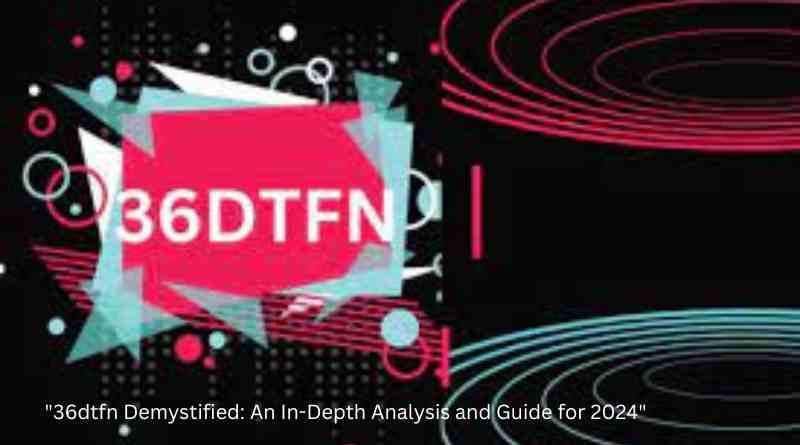In the ever-evolving landscape of data analysis and predictive modeling, one term has emerged as both a key player and an enigmatic mystery – “36dtfn.” As data analysts, statisticians, and machine learning enthusiasts gear up for the challenges and opportunities that 2024 holds, understanding the intricacies of this concept is paramount.
“36dtfn” is not just another buzzword; it’s a fundamental piece of the data puzzle that has the potential to reshape the way we approach and interpret data. In this comprehensive article, we embark on a journey to demystify the nuances of “36dtfn,” providing you with an in-depth analysis and a comprehensive guide to its relevance in 2024.
Understanding 36dtfn
To truly grasp the significance of “36dtfn” in the realm of data analysis and predictive modeling, it’s essential to start with a clear definition and an exploration of its origins.
Defining 36dtfn:
At its core, “36dtfn” is an acronym that stands for “36 Days to First Notice,” and it plays a pivotal role in the insurance industry, particularly in assessing risk and predicting future events. This metric measures the time elapsed from the occurrence of an insured event, such as an accident or damage, to the moment when it is first reported or noticed by the insurance company.
In essence, 36dtfn represents the speed at which insurance claims are reported, and it serves as a critical factor in evaluating the efficiency of claims processing and the potential for fraud detection. Understanding this concept is paramount for insurance companies, as it directly impacts their ability to manage risk and allocate resources effectively.
Origins and Historical Context:
The concept of 36dtfn has deep historical roots within the insurance industry. It emerged as a response to the need for insurers to streamline their claims processing and fraud detection mechanisms. In the past, delays in reporting insurance claims could lead to increased costs and opportunities for fraudulent activities. Therefore, the development of a standardized metric like 36dtfn became essential.
Over the years, advancements in data analytics, machine learning, and statistical modeling have further enhanced the utility of 36dtfn. It is now considered a cornerstone in the field of insurance data analysis, enabling companies to make more informed decisions and improve their overall operations.
Significance in Data Analysis:
The significance of 36dtfn extends beyond the insurance sector. In broader data analysis contexts, it serves as a prime example of how timely data collection and reporting can impact decision-making. The principles and methodologies associated with 36dtfn can be adapted and applied in various industries where the speed of data acquisition and processing is critical.
For instance, in healthcare, the time from symptom onset to medical intervention can be analogous to 36dtfn. Timely reporting of disease outbreaks or adverse events is vital for effective healthcare management and public health response.

The Role of 36dtfn in Data Analysis
As we continue our journey into understanding “36dtfn,” it’s crucial to explore its pivotal role in the field of data analysis. While it originated in the insurance industry, 36dtfn has transcended its initial confines and found applications in various sectors where timely data analysis is paramount.
Measuring Efficiency and Risk Assessment:
In the realm of data analysis, 36dtfn serves as a key metric for measuring efficiency and assessing risk. It enables organizations to evaluate the speed at which events or incidents are reported and processed, shedding light on their operational effectiveness.
For insurance companies, a shorter 36dtfn often indicates prompt and efficient claims processing. This can lead to reduced operational costs, improved customer satisfaction, and enhanced risk assessment. On the contrary, a prolonged 36dtfn may raise concerns about delays, potential fraud, or inadequate claims handling.
Fraud Detection and Prevention:
One of the most critical applications of 36dtfn in data analysis is in fraud detection and prevention. By analyzing patterns in the reporting of insurance claims, data analysts can identify anomalies or irregularities that may indicate fraudulent activities.
For instance, a significant delay in reporting an accident or damage could be a red flag. It might suggest that the claimant is attempting to hide certain details or inflate the claim. Through sophisticated data analysis techniques, including machine learning algorithms, anomalies can be detected and investigated, helping insurance companies combat fraud effectively.
Predictive Modeling and Decision-Making:
In the age of data-driven decision-making, 36dtfn provides valuable insights that can inform predictive modeling efforts. By analyzing historical data on 36dtfn along with other relevant variables, organizations can build predictive models to forecast future trends in claims reporting.
These models can help insurance companies anticipate peak claim periods, allocate resources efficiently, and optimize their claims processing workflows. This proactive approach can lead to cost savings and improved customer service.
Cross-Industry Applications:
While 36dtfn’s origins lie in insurance, its principles can be adapted to other industries. For example:
- In healthcare, the time it takes for adverse events or disease outbreaks to be reported can be analogous to 36dtfn. Timely reporting is crucial for public health interventions and patient care.
- In supply chain management, the speed of reporting product defects or disruptions in the supply chain can impact decision-making, inventory management, and customer satisfaction.
- In financial services, the rapid reporting of fraudulent transactions or market anomalies is vital for risk management and regulatory compliance.
Continuous Improvement and Optimization:
Incorporating 36dtfn into data analysis processes encourages organizations to focus on continuous improvement. By monitoring and analyzing this metric over time, companies can identify bottlenecks, streamline processes, and enhance their overall operations.
Defining Predictive Modeling:
Predictive modeling is a process that utilizes historical data to build models that can make predictions about future events or outcomes. These models rely on various variables and statistical techniques to make informed forecasts. In the context of 36dtfn, predictive modeling aims to anticipate the time it takes for an event to be reported based on historical patterns and factors.
Incorporating 36dtfn into Predictive Models:
Predictive models often involve the analysis of time-series data, where the timing of events is crucial. 36dtfn serves as a valuable feature or variable in such models, as it encapsulates the time aspect of data reporting.
For instance, in the insurance industry, predictive models can incorporate historical 36dtfn data along with other relevant factors such as the type of insurance, geographical location, and past claims history. By analyzing these variables, the model can predict the likely 36dtfn for future claims.
Benefits of Using 36dtfn in Predictive Modeling:
- Improved Resource Allocation: Predictive models that consider 36dtfn can help insurance companies allocate resources more efficiently. For instance, during peak claim periods, they can anticipate a higher volume of claims and assign staff accordingly.
- Fraud Detection: 36dtfn can be a crucial input for fraud detection models. Sudden deviations from expected 36dtfn patterns can trigger alerts, prompting further investigation into potential fraudulent claims.
- Optimized Claims Processing: Predictive models can assist in streamlining claims processing workflows. By predicting 36dtfn, insurers can prioritize and expedite claims that are likely to take longer, enhancing customer satisfaction.
- Cost Savings: Efficient resource allocation and reduced fraud can lead to cost savings for insurance companies. Predictive models that factor in 36dtfn can contribute to a more cost-effective claims management process.
- Data-Driven Decision-Making: By leveraging predictive modeling with 36dtfn, organizations can make data-driven decisions that enhance their overall operations and customer service.

Challenges and Considerations:
While 36dtfn can be a valuable component in predictive modeling, it’s essential to recognize some challenges. These may include dealing with missing data, handling outliers, and selecting appropriate algorithms and features. Additionally, the interpretation of the model’s predictions is critical for informed decision-making.
Research and Innovation:
The integration of 36dtfn into predictive modeling is an area of ongoing research and innovation. Researchers and data analysts are continuously exploring ways to enhance the accuracy and applicability of predictive models by considering time-related factors like 36dtfn.
In conclusion, 36dtfn plays a pivotal role in predictive modeling by providing insights into the timing of events and data reporting. Its inclusion in models can lead to improved resource allocation, fraud detection, cost savings, and data-driven decision-making. As technology and data analysis techniques advance, the relationship between 36dtfn and predictive modeling is likely to evolve, offering new opportunities for optimization and innovation in various industries.
Statistical Insights into 36dtfn
In our exploration of “36dtfn,” it’s essential to uncover the statistical aspects that underlie this concept. Statistical analysis is a fundamental tool for understanding the patterns, trends, and implications of 36dtfn data. Let’s delve into some key statistical insights:
1. Descriptive Statistics:
Descriptive statistics provide an initial overview of 36dtfn data. Common descriptive measures include:
- Mean (Average): This measures the central tendency of 36dtfn values, giving an idea of the typical time it takes for events to be reported.
- Standard Deviation: It quantifies the variability or dispersion in 36dtfn values, indicating how much they deviate from the mean.
- Median: This is the middle value when 36dtfn values are sorted, which can provide insight into the central tendency if the data is skewed.
By calculating these statistics, analysts can gain a sense of the typical reporting times and the spread of 36dtfn values.
2. Time Series Analysis:
Time series analysis is a powerful statistical technique for understanding how 36dtfn evolves over time. It involves examining historical data to identify trends, seasonality, and patterns. This analysis can reveal whether there are recurring patterns in 36dtfn, such as daily or weekly variations, which can be crucial for resource allocation and decision-making.
3. Hypothesis Testing:
Statistical hypothesis testing can help answer specific questions about 36dtfn data. For example, you might want to test whether there’s a significant difference in 36dtfn between different types of insurance claims. Hypothesis tests, such as t-tests or analysis of variance (ANOVA), can provide insights into such comparisons.
4. Regression Analysis:
Regression analysis allows you to model the relationship between 36dtfn and other variables. For instance, you could build a regression model to predict 36dtfn based on factors like the type of insurance, location, or claim amount. This can be particularly valuable for predictive modeling and decision-making.
5. Outlier Detection:
Identifying outliers in 36dtfn data is crucial, as extreme values can skew statistical analyses and lead to inaccurate insights. Statistical methods like the Z-score or the IQR (Interquartile Range) can help detect and handle outliers effectively.
6. Distribution Analysis:
Understanding the distribution of 36dtfn values is essential for making statistical inferences. Depending on the data, it may follow a particular distribution, such as the normal distribution, or exhibit a skewed or non-parametric distribution. Choosing the right distribution model is important for making valid statistical assumptions.
7. Correlation Analysis:
Correlation analysis can reveal relationships between 36dtfn and other variables. For example, you might investigate whether there’s a correlation between 36dtfn and the time of day or the geographical location of claims reporting. Correlation coefficients like Pearson’s r or Spearman’s rank correlation can quantify these relationships.
8. Time-to-Event Analysis:
Time-to-event analysis, also known as survival analysis, is particularly relevant when dealing with 36dtfn, as it focuses on the time until an event of interest occurs. This analysis is used to estimate survival curves and assess factors that affect the timing of events.
Scientific References:
To dive deeper into the statistical aspects of 36dtfn, consider referring to scientific papers, journal articles, or books that discuss relevant statistical techniques and their application to time-based data analysis. These sources can provide a more comprehensive understanding of the statistical insights associated with 36dtfn in specific contexts.
Incorporating statistical analysis into your exploration of 36dtfn can provide valuable insights and help you make informed decisions based on the data’s underlying patterns and trends.
Read also: check

